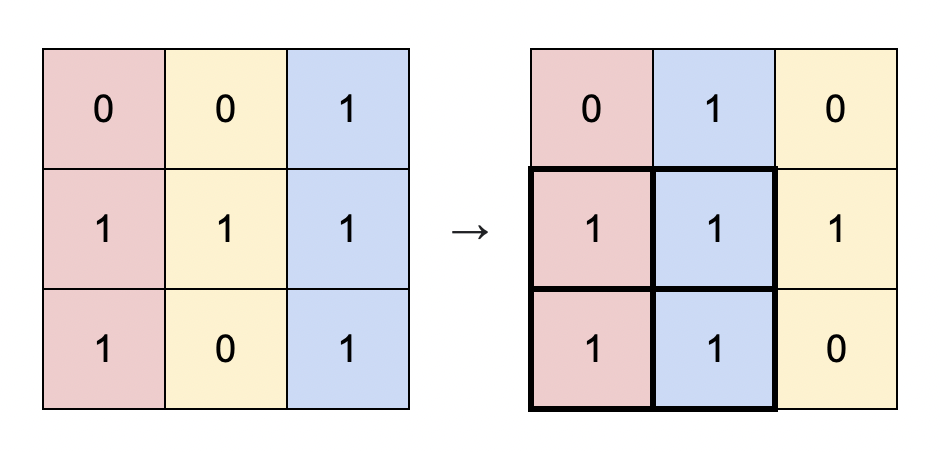Problem
You are given a binary matrix matrix of size m x n, and you are allowed to rearrange the columns of the matrix in any order.
Return **the area of the largest submatrix within *matrix* where every element of the submatrix is 1 after reordering the columns optimally.**
Example 1:

Input: matrix = [[0,0,1],[1,1,1],[1,0,1]]
Output: 4
Explanation: You can rearrange the columns as shown above.
The largest submatrix of 1s, in bold, has an area of 4.
Example 2:

Input: matrix = [[1,0,1,0,1]]
Output: 3
Explanation: You can rearrange the columns as shown above.
The largest submatrix of 1s, in bold, has an area of 3.
Example 3:
Input: matrix = [[1,1,0],[1,0,1]]
Output: 2
Explanation: Notice that you must rearrange entire columns, and there is no way to make a submatrix of 1s larger than an area of 2.
Constraints:
m == matrix.lengthn == matrix[i].length1 <= m * n <= 105matrix[i][j]is either0or1.
Solution 1
/**
* @param {number[][]} matrix
* @return {number}
*/
var largestSubmatrix = function(matrix) {
var max = 0;
for (var i = 0; i < matrix.length; i++) {
for (var j = 0; j < matrix[i].length; j++) {
if (matrix[i][j] !== 0 && i > 0) {
matrix[i][j] = matrix[i - 1][j] + 1;
}
}
var arr = [...matrix[i]].sort((a, b) => b - a);
for (var j = 0; j < arr.length; j++) {
if (arr[j] === 0) break;
max = Math.max(max, arr[j] * (j + 1));
}
}
return max;
};
Explain:
nope.
Complexity:
- Time complexity : O(n * m * log(m)).
- Space complexity : O(1).
Solution 2
/**
* @param {number[][]} matrix
* @return {number}
*/
var largestSubmatrix = function(matrix) {
var max = 0;
var lastHeights = [];
for (var i = 0; i < matrix.length; i++) {
var seen = {};
for (var j = 0; j < matrix[i].length; j++) {
if (matrix[i][j] === 1) {
i > 0 && (matrix[i][j] = matrix[i - 1][j] + 1);
seen[j] = true;
}
}
var heights = [];
// old ones
var used = {};
for (var k = 0; k < lastHeights.length; k++) {
var item = lastHeights[k];
if (seen[item[1]]) {
heights.push([item[0] + 1, item[1]]);
used[item[1]] = true;
}
}
// new ones
var keys = Object.keys(seen);
for (var n = 0; n < keys.length; n++) {
if (!used[keys[n]]) {
heights.push([1, Number(keys[n])]);
}
}
for (var m = 0; m < heights.length; m++) {
max = Math.max(max, heights[m][0] * (m + 1));
}
lastHeights = heights;
}
return max;
};
Explain:
nope.
Complexity:
- Time complexity : O(n * m).
- Space complexity : O(m).